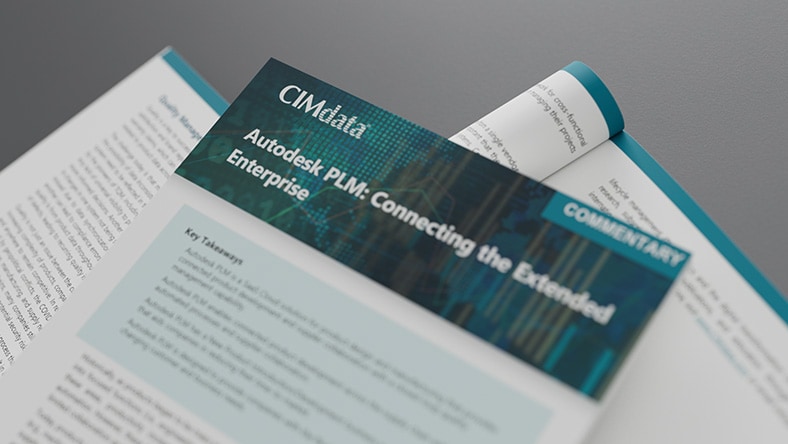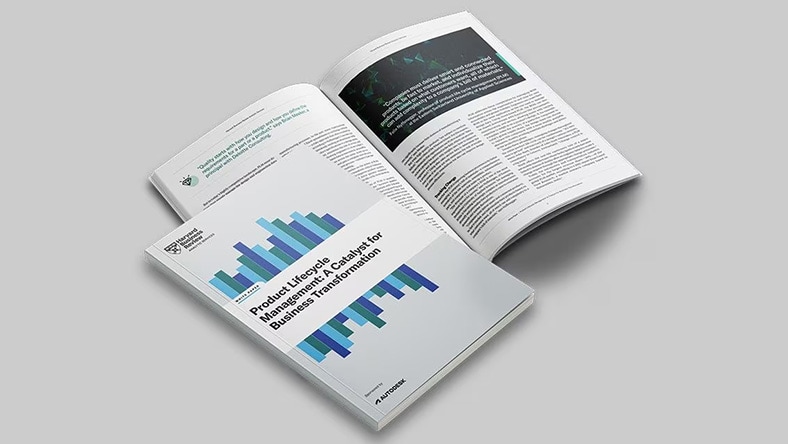& Construction

Integrated BIM tools, including Revit, AutoCAD, and Civil 3D
& Manufacturing

Professional CAD/CAM tools built on Inventor and AutoCAD
Quality and reliability can often be two of the most important considerations for customers, significantly impacting brand equity. But the path to get there can be filled with challenges. With Autodesk cloud PLM, you can mitigate potential issues by giving your engineering teams the tools they need to close the loop on quality—improving designs, identifying supplier problems, and bringing better products to market faster.
See why product quality management is a top priority for manufacturers.
Identify and drive corrective actions with comprehensive incident reporting, analysis, and disposition processes. Spot trends in quality metrics for preventive measures.
Manage root-cause failure identification and verification processes. Maintain records of the results for each type of functional, design, or process analysis for reference and compliance purposes.
Improve the handling of return merchandise authorization requests, disposition, approval, and repair processes. Automate routine tasks such as issuing RMA numbers and sending customer emails.
Assign tasks for corrective and preventive actions projects. Then tie CAPAs to your Change Request and Change Order implementation processes.
Track supplier performance and quality, and request supplier corrective actions as needed. Keep track of SCARs issued, actions taken, and eventual outcomes for records.
Trace specific quality issues end-to-end with structured quality management processes recording the history of issues, actions, and electronic signatures to satisfy auditors.
Communicate changes, requirements, test procedures, and manufacturing controls with a closed-loop system managing connected quality data and product development processes for the entire organization.
Keep everyone up-to-date with real-time alerts including assigned tasks, almost due, late or escalated tasks, approvals, changes, and more. Messages are configured to optimize relevance and action.
Gain real-time views of product quality, defects, and change orders at-a-glance in a centralized system. Quickly generate reports on trends and progress status towards meeting quality goals.
WEBINAR SERIES
Learn from Autodesk experts about PLM tips, tricks, and best practices. View our library of webinars to learn how you can streamline collaboration, increase agility, and improve product quality with Autodesk PLM.
COMMENTARY
Learn why analyst CIMdata believes cloud PLM not only reduces defects and nonconformities, but also increases visibility into the impact of your quality processes.
REPORT
Explore how cloud PLM workflows not only streamline processes but also serve as catalysts for business transformation in this report from Harvard Business Review Analytic Services.
Bring all your project data into one place to reduce time spent on low-value tasks, increase product development agility, and streamline collaboration with centralized product-related data and processes.
Increase BOM management effectiveness by documenting, tracking, and reviewing every component in your product—to better prepare for manufacturing, and maintain data integrity throughout your entire product lifecycle.
Deliver enterprise-wide visibility and traceability by enforcing control over revisions to designs, items, and records during all your product lifecycle phases—and help departments efficiently automate and document revisions.
Accelerate the time from concept to production with configurable project templates and standardized phase-gate milestones, deliverables, and tasks—by product line, business unit, or product team.
Connect your extended organization to the information it needs for quoting, procurement, and supplier management—anytime, anywhere—with 24/7 access to your global supply chain.
Keep everyone on the same page no matter what CAD software they use—with a single source of data that improves collaboration, increases development agility, and accelerates time to market.
Getting started with Autodesk cloud PLM is within reach. Talk to your account team about how modular processes and configurable, out-of-the-box workflows offer the flexibility to implement what you need, when you need it.
Product lifecycle management (PLM) for quality management is a systematic approach that integrates quality assurance processes throughout the entire lifecycle of a product, from inception to retirement. It helps businesses manage and prevent quality issues, ensuring the highest standards of their products and services. By centralizing product data, a PLM system can facilitate collaboration among different departments and stakeholders, which is crucial for maintaining product quality. Using a PLM system enables organizations to track the revision history of product designs and document the decision-making process, which can be important for resolving quality issues and identifying areas for improvement.
Product lifecycle management systems play a key role in non-conformance management. PLM can identify and track non-conformances, which are instances where a product or process fails to meet specified standards. This system allows businesses to take timely corrective actions, reducing the risk of repeated non-conformances and maintaining product quality. PLM systems provide tools for tracking non-conformances over time. This makes it easier to monitor ongoing issues, understand their impact, and evaluate the effectiveness of corrective actions. With PLM systems, information about non-conformances and corrective actions can be easily shared across the organization. This can improve collaboration and ensure that everyone is working from the same information. PLM helps organizations manage complete, traceable records of non-conformances and corrective actions. This is crucial for helping companies demonstrate compliance with quality standards and regulations, and for preparing for audits.
RMA stands for Return Merchandise Authorization in product lifecycle management (PLM) for quality management. It's a process used by companies to manage the return of defective or unwanted products from customers. When a customer encounters a problem with a product, they contact the company to request an RMA. The PLM system captures all necessary details such as customer information, product details, and issue description. If approved, the customer can return the product for repair, replacement, or refund. Upon receipt, the item is inspected for the reported issue. The PLM system helps track and document this inspection process and manages the RMA process to track the returned product through repair or replacement. The PLM system can help analyze these returns to identify patterns or recurring issues, leading to corrective and preventive actions. PLM systems typically provide extensive reporting and analytics capabilities. This can help in tracking the performance of the RMA process as well, identifying bottlenecks, and making data-driven decisions for process improvement. Valuable information about product defects can be used for quality management and improvement.
PLM systems can help standardize and automate the CAPA process, facilitating the identification of problems, implementation of corrective actions, and monitoring of results. For example, when a product problem is identified, a PLM system can help manage the root cause analysis process to understand why the issue happened. This could involve reviewing design documents, production data, supplier information, and more. A PLM system can help provide full traceability of CAPA processes, including records and events that occur before and after the CAPA. This represents the CAPA processes to anyone within the organization and auditors, improving a general understanding of what the process entails, and providing process proof to help meet compliance requirements. This helps prevent the recurrence of quality issues and continuously improves product quality.
Yes, PLM systems are capable of conducting comprehensive failure analysis. PLM systems help in collecting and organizing data related to product failures. This includes details about the product, its usage, the nature and frequency of the failure, environmental conditions, and more. This data can be collected from various sources including product returns (RMA), warranty claims, customer feedback, and field reports. They can collect and analyze data to determine the root cause of product or process failures, enabling businesses to take informed actions to prevent future issues. PLM systems provide a comprehensive approach to failure analysis, helping to improve product quality and reliability, reduce warranty costs, and enhance customer satisfaction.
Closed-loop quality management is a proactive approach in PLM that continuously monitors and improves quality. It involves connecting quality data and product development processes to enhance quality earlier. It controls quality and change management processes with connected, automated workflows. From non-conformance identification and analysis, to return merchandize authorizations and implementing corrective and preventive actions, teams have the visibility they need to respond quickly to product quality issues. It also involves a feedback loop for engineering to incorporate learnings into the product design and make changes that improve product quality. With closed-loop quality management in PLM, quality is integral to the entire organization's operations, from product design to manufacturing and other areas of the business for continual product quality improvement and better business outcomes.
PLM for quality management can enhance product quality, reduce costs related to defects and rework, improve customer satisfaction, and ensure regulatory compliance. It provides a centralized system that streamlines quality management processes, making them more efficient and effective. With integrated data and analytics, PLM systems provide valuable insights for decision-making. You can identify trends, make predictions, and make data-driven decisions. Using a PLM system can help ensure compliance with industry and government regulations, as well as standards for quality and safety. This can reduce the risk of penalties and damage to your company's reputation. PLM can also improve your business by providing closed-loop feedback from the field about quality issues or failures that can be traced back to the original design, thereby enabling continuous improvement. By helping to ensure the delivery of high-quality products and efficient handling of issues, PLM can greatly enhance customer satisfaction and brand loyalty.
While PLM for quality management is particularly beneficial for industries like manufacturing, automotive, and aerospace, any business that seeks to maintain and improve the quality of its products or services can benefit from it. Using a PLM system helps streamline product development processes, ensure compliance with industry standards, and reduce time to market. While PLM is suitable for different industries, the specific implementation and use of PLM can vary based on the industry and the specific needs of the business. Therefore, it's important to choose a PLM system that is flexible and can be customized to meet your specific requirements.
PLM systems can seamlessly integrate with other enterprise systems like ERP, CRM, and MES. For example, Autodesk Fusion Manage is a cloud-based PLM system with an open API for ease with integrations. Integration ensures that all systems are using the same, up-to-date information. These integrations help break down silos, improve collaboration, speed up processes, and reduce errors caused by manual data transfers. It helps ensure real-time data exchange, providing a complete view of the product lifecycle, and enabling informed decision-making. Connect PLM with other business systems so you can extend the value of your product data to other departments and people. Gain insights and efficiency with cross-functional information sharing.
The implementation process depends on various factors like the size of your business, existing systems, and specific requirements. Implementing a new system often requires changes in business processes and workflows. It's important to manage change effectively and ensure all stakeholders understand the benefits of the PLM system. Getting buy-in from key stakeholders and training users on the new system is important. With the right support and planning, PLM for quality management can be implemented effectively, resulting in long-term benefits for your organization. Benefits including improved product quality, faster time-to-market, and cost savings can make it worthwhile for organizations to implement PLM.
Product lifecycle management systems play a crucial role in managing the Bill of Materials (BOM) (US Site). A BOMs is a comprehensive inventory of the raw materials, assemblies, sub-assemblies, parts, and the quantities of each needed to manufacture a product. With a PLM system, companies can create and manage accurate BOMs from the earliest stages of product design. This ensures that the quality of the product is considered from the start, and any changes in design are accurately reflected in the BOM. PLM systems can track revisions and changes to the BOM in real-time. It ensures that all stakeholders are working with the most up-to-date information, which is critical for maintaining quality standards. If a quality issue arises, the BOM can help identify the problematic component and rectify the issue. PLM systems facilitate collaboration between different departments (like design, manufacturing, and procurement). Sharing BOM information can help identify potential quality issues early on and ensure that all components meet the necessary quality standards.
Yes, PLM systems can help manage and control the quality of products throughout their lifecycle, which includes the supply chain process. PLM provides a centralized system where all product information can be stored and accessed. This includes design specifications, manufacturing plans, quality standards, and more. Suppliers can have access to this information, ensuring they are working with the most up-to-date and accurate product data, reducing the chances of errors. Connected quality management and supplier collaboration processes (US Site) in PLM allows suppliers to directly input their quality control data into the system, making it easier to track and monitor product quality across the entire supply chain. The PLM system can be used to track and manage supplier quality metrics, performance, and compliance with standards. It can also provide collaboration workflows with suppliers, making it easier to manage quality issues and improve efficiency.
Autodesk provides a product lifecycle management (PLM) solution for quality management known as Autodesk Fusion Manage. Fusion Manage is a cloud-based PLM solution with configurable, out-of-the box PLM processes that are easy to use. It enhances workflows and improves collaboration for everyone involved in product development across the organization and extended stakeholders. With its open API, Fusion Manage integrates with other business systems like PDM, ERP, and CRM. Quality management within Autodesk's PLM solution includes a set of processes that anticipate, control, and respond to potential product quality issues. Processes such as field failure reports, nonconformance, and corrective/preventative actions provide efficiency and traceability. Quality and engineering have a closed-loop change process to improve product designs.
Product quality management is a strategic and systematic approach to managing product information and processes throughout the entire product lifecycle. It helps in anticipating, controlling, and responding to potential product quality issues. Product lifecycle management (PLM) software is used for quality management. PLM software integrates people, processes, data, and business systems and provides a product information backbone for companies and their extended enterprise. Using PLM for product quality management helps organizations reduce operational risks, enhance quality control, and drive continuous improvement. PLM software like Autodesk Fusion Manage helps improve product quality and traceability with automated processes to manage non-conformance, return merchandise authorizations (RMA), corrective/preventative actions (CAPA), failure mode and effect analysis (FMEA), and supplier quality action reports (SCAR). Quality and engineering have a closed-loop change process to improve product designs, identify supplier problems, and make corrections.



